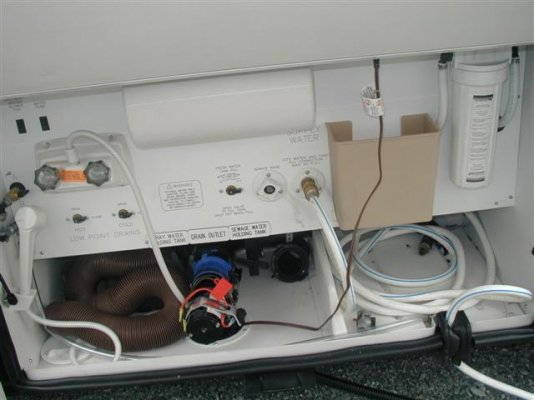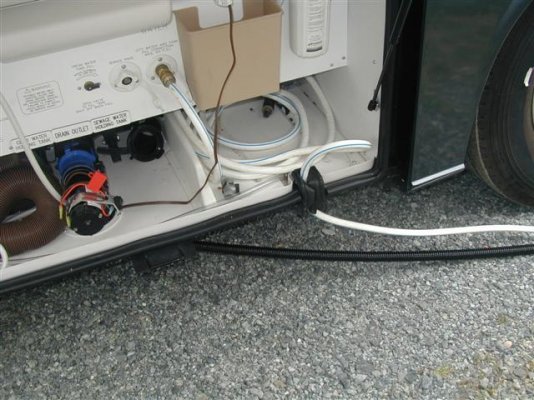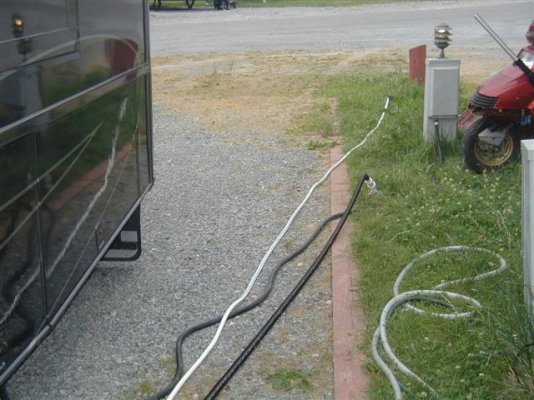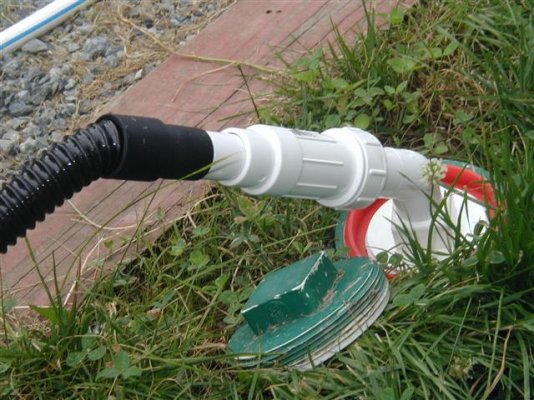Smoky
Well-known member
Well just 2 years ago was my introduction to the wonderful world of RVing. Having fished and boated for 60 years (yes I began at an early age), I found RVing had much in common with boating.
RVing travel was similar but less restricted, RV maintenance was important, but less demanding physically, fellowship was not only equal to boating, but better, and gadgetry was equal in both camps. Not hard for a 60 something senior citizen to convert over.
Except....
I was astonished to see no maceration going on. If I may speak bluntly, both liquid and solid objects were being dumped directly into a hole in the ground. I thought this was strange, and possibly inefficient, but I adjusted quickly.
Since 2003 never gave any more thought about it... until I began shopping in earnest for our new motorhome. One of the interesting motorhomes that made our "short" list was Monaco's Beaver Santiam. As we toured through the home and then began opening bay doors, I suddenly saw something familiar when the utility bay was opened. By God a macerator!
The salesman said they were a new option in 2005 on Monacos, but he had very little idea what they did or why they would be an attractive feature. I walked away impressed. Later, when I knew I was not going to buy a Beaver, I pretended to be still interested (naughty me) and inquired if I could install my own macerator on the early 2005 Beaver they had on the lot that was not macerized. They said they would check, and later got back to me with the phone number of the company that was supplying them and a Xerox copy of the manual. (This was a very nice dealer in Virginia I must admit.)
When I read through the manual I realized I had stumbled on something very good. One of the capabilities of this macerator is that it can pump sewage up 20 feet in elevation and up to 350 feet away. The hoses are 3/4 inch small diameter accordion type expandable hoses. They take up less than a quarter of the same length standard 3 inch gravity sewage hose.
The macerator itself just twists on to your black water outlet like a standard sewer hose. Thus if for some reason you want to dump the normal way, you can just twist off the macerator and twist on the standard hose. I thought I might do this when on the move at truck or highway dump stops, but the macerator is so easy to use I leave it attached at all times. You do not even have to rinse hoses, as when you are done you simply twist on a hose cap and you have a "closed" system ready for use the next time. However in campgrounds I go ahead and run my gray water after the black water and give it a rinse. Makes me feel better. ;D
There is also a gray water bypass for those who want there gray water constantly flowing. I take advantage of this when we have our washer dryer running.
This setup seemed to me to be about perfect for a fulltimer. In fact I later discovered that the Escapee web site has a full and often humorous ?white paper? on fulltiming and maceration.
At any rate, for me I was thinking they are compact, easy to use, and will get you to your host's house sewage tap even if it is a hundred feet away and uphill. This is one of the reasons we have refused to use chemicals in our new holding tank and only use bacteria. Keeps it septic tank friendly.
They are wired for 12 volts. When I ordered my coach I had heavy duty 12 volts wiring supplied at the utility bay. I self installed the Sani-con and it took 2 minutes. The hard part is wiring the 12 volt outlet and Newmar did this for me. I later changed what Newmar did, because it was a cigarette lighter style output, and it is hard to find the male connector for 25 amps. I replaced the Newmar box with standard 110 volt receptacle, but wired the receptacle using the 12 volt wiring. I just plug in when I am camped. I like unplugging it when I travel.
You can extend hosing by simply adding 3/4" standard garden hoses. Or buy more of those accordion extensions from RV Sani-Con, the company that manufactures all this.
I had a long conversation with the owner of Sani-con. Interestingly, he stumbled on this just like I did. Switched from boating to RVing and was astonished no manufacturer was providing maceration. He made up one for himself using a standard Jabsco marine macerator. Then when he camped, others would constantly come over and ooh and ah. Sometimes they would bug him to make up another and sell it to them and he always said no but would show them what to do to make it themselves. Then one day his wife said yes, and he was stuck making one. He figured making ten was more efficient than making one and planned to take a fresh one with him for possible sale at each campground.
He got orders for all ten at the next campground!
He has since refined the process many times. Now he has contracts with Monaco and two other companies, and Newmar is doing some field tests. In fact when I ordered my 12 volt utility bay circuit, Newmar asked me to report back in 6 months and give them feedback on the Sani-Con.
Attached are pictures of my own setup.
1. Our utility bay. Macerator is already set up and attached to sewer. In this picture you cannot see the black accordion hose. It is running out the port directly underneath the macerator. You can see the unused 20 foot standard 3 inch hose on stored and inactive on the left. At some point we are going to ditch this hose and only keep the 10 foot standard hose which rides in the out of sight little hose compartment provided by Newmar.
2. Closeup of macerator.
3. Bay door area showing black accordion hose coming out below the bay along with fresh water hose.
4. Utility path shown for fresh water (white hose), waste water (black accordion hose), and power, black power cord. Note how unobtrusive the accordion hose is. Makes everything look more tidy behind the coach.
5. The sewage hookup.
Wondering if anyone else here is using maceration, and if so, home-brew or manufactured?
RVing travel was similar but less restricted, RV maintenance was important, but less demanding physically, fellowship was not only equal to boating, but better, and gadgetry was equal in both camps. Not hard for a 60 something senior citizen to convert over.
Except....
I was astonished to see no maceration going on. If I may speak bluntly, both liquid and solid objects were being dumped directly into a hole in the ground. I thought this was strange, and possibly inefficient, but I adjusted quickly.
Since 2003 never gave any more thought about it... until I began shopping in earnest for our new motorhome. One of the interesting motorhomes that made our "short" list was Monaco's Beaver Santiam. As we toured through the home and then began opening bay doors, I suddenly saw something familiar when the utility bay was opened. By God a macerator!
The salesman said they were a new option in 2005 on Monacos, but he had very little idea what they did or why they would be an attractive feature. I walked away impressed. Later, when I knew I was not going to buy a Beaver, I pretended to be still interested (naughty me) and inquired if I could install my own macerator on the early 2005 Beaver they had on the lot that was not macerized. They said they would check, and later got back to me with the phone number of the company that was supplying them and a Xerox copy of the manual. (This was a very nice dealer in Virginia I must admit.)
When I read through the manual I realized I had stumbled on something very good. One of the capabilities of this macerator is that it can pump sewage up 20 feet in elevation and up to 350 feet away. The hoses are 3/4 inch small diameter accordion type expandable hoses. They take up less than a quarter of the same length standard 3 inch gravity sewage hose.
The macerator itself just twists on to your black water outlet like a standard sewer hose. Thus if for some reason you want to dump the normal way, you can just twist off the macerator and twist on the standard hose. I thought I might do this when on the move at truck or highway dump stops, but the macerator is so easy to use I leave it attached at all times. You do not even have to rinse hoses, as when you are done you simply twist on a hose cap and you have a "closed" system ready for use the next time. However in campgrounds I go ahead and run my gray water after the black water and give it a rinse. Makes me feel better. ;D
There is also a gray water bypass for those who want there gray water constantly flowing. I take advantage of this when we have our washer dryer running.
This setup seemed to me to be about perfect for a fulltimer. In fact I later discovered that the Escapee web site has a full and often humorous ?white paper? on fulltiming and maceration.
At any rate, for me I was thinking they are compact, easy to use, and will get you to your host's house sewage tap even if it is a hundred feet away and uphill. This is one of the reasons we have refused to use chemicals in our new holding tank and only use bacteria. Keeps it septic tank friendly.
They are wired for 12 volts. When I ordered my coach I had heavy duty 12 volts wiring supplied at the utility bay. I self installed the Sani-con and it took 2 minutes. The hard part is wiring the 12 volt outlet and Newmar did this for me. I later changed what Newmar did, because it was a cigarette lighter style output, and it is hard to find the male connector for 25 amps. I replaced the Newmar box with standard 110 volt receptacle, but wired the receptacle using the 12 volt wiring. I just plug in when I am camped. I like unplugging it when I travel.
You can extend hosing by simply adding 3/4" standard garden hoses. Or buy more of those accordion extensions from RV Sani-Con, the company that manufactures all this.
I had a long conversation with the owner of Sani-con. Interestingly, he stumbled on this just like I did. Switched from boating to RVing and was astonished no manufacturer was providing maceration. He made up one for himself using a standard Jabsco marine macerator. Then when he camped, others would constantly come over and ooh and ah. Sometimes they would bug him to make up another and sell it to them and he always said no but would show them what to do to make it themselves. Then one day his wife said yes, and he was stuck making one. He figured making ten was more efficient than making one and planned to take a fresh one with him for possible sale at each campground.
He got orders for all ten at the next campground!
He has since refined the process many times. Now he has contracts with Monaco and two other companies, and Newmar is doing some field tests. In fact when I ordered my 12 volt utility bay circuit, Newmar asked me to report back in 6 months and give them feedback on the Sani-Con.
Attached are pictures of my own setup.
1. Our utility bay. Macerator is already set up and attached to sewer. In this picture you cannot see the black accordion hose. It is running out the port directly underneath the macerator. You can see the unused 20 foot standard 3 inch hose on stored and inactive on the left. At some point we are going to ditch this hose and only keep the 10 foot standard hose which rides in the out of sight little hose compartment provided by Newmar.
2. Closeup of macerator.
3. Bay door area showing black accordion hose coming out below the bay along with fresh water hose.
4. Utility path shown for fresh water (white hose), waste water (black accordion hose), and power, black power cord. Note how unobtrusive the accordion hose is. Makes everything look more tidy behind the coach.
5. The sewage hookup.
Wondering if anyone else here is using maceration, and if so, home-brew or manufactured?





